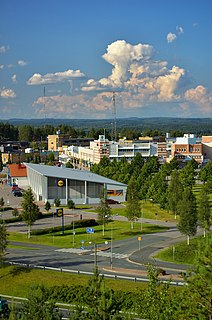Related Research Articles

A supermarket is a self-service shop offering a wide variety of food, beverages and household products, organized into sections. This kind of store is larger and has a wider selection than earlier grocery stores, but is smaller and more limited in the range of merchandise than a hypermarket or big-box market. In everyday U.S. usage, however, "grocery store" is synonymous with supermarket, and is not used to refer to other types of stores that sell groceries.

Retail is the sale of goods and services to consumers, in contrast to wholesaling, which is sale to business or institutional customers. A retailer purchases goods in large quantities from manufacturers, directly or through a wholesaler, and then sells in smaller quantities to consumers for a profit. Retailers are the final link in the supply chain from producers to consumers.
Sales promotion is one of the elements of the promotional mix. The primary elements in the promotional mix are advertising, personal selling, direct marketing and publicity/public relations. Sales promotion uses both media and non-media marketing communications for a pre-determined, limited time to increase consumer demand, stimulate market demand or improve product availability. Examples include contests, coupons, freebies, loss leaders, point of purchase displays, premiums, prizes, product samples, and rebates.

Retail loss prevention is a set of practices employed by retail companies to preserve profit. Profit preservation is any business activity specifically designed to reduce preventable losses. A preventable loss is any business cost caused by deliberate or inadvertent human actions, colloquially known as "shrinkage". Loss prevention is mainly found within the retail sector but also can be found within other business environments.

A big-box store is a physically large retail establishment, usually part of a chain of stores. The term sometimes also refers, by extension, to the company that operates the store.

Planograms, also known as plano-grams, plan-o-grams, schematics and POGs, are visual representations of a store's products or services on display. They are considered a tool for visual merchandising. According to the Merriam-Webster Dictionary, a planogram is "a schematic drawing or plan for displaying merchandise in a store so as to maximize sales." The effectiveness of the planogram can be measured by the sales volume generated from the specific area being diagrammed.
Service Merchandise was a retail chain of catalog showrooms carrying jewelry, toys, sporting goods, and electronics. The company, which first began in 1934 as a five-and-dime store, was in existence for 68 years before ceasing operations in 2002.
In marketing, geomarketing is a discipline that uses geolocation in the process of planning and implementation of marketing activities. It can be used in any aspect of the marketing mix — the product, price, promotion, or place. Market segments can also correlate with location, and this can be useful in targeted marketing.

Category management is a retailing and purchasing concept in which the range of products purchased by a business organization or sold by a retailer is broken down into discrete groups of similar or related products; these groups are known as product categories. It is a systematic, disciplined approach to managing a product category as a strategic business unit. The phrase "category management" was coined by Brian F. Harris.

Once the strategic plan is in place, retail managers turn to the more managerial aspects of planning. A retail mix is devised for the purpose of coordinating day-to-day tactical decisions. The retail marketing mix typically consists of six broad decision layers including product decisions, place decisions, promotion, price, personnel and presentation. The retail mix is loosely based on the marketing mix, but has been expanded and modified in line with the unique needs of the retail context. A number of scholars have argued for an expanded marketing, mix with the inclusion of two new Ps, namely, Personnel and Presentation since these contribute to the customer's unique retail experience and are the principal basis for retail differentiation. Yet other scholars argue that the Retail Format should be included. The modified retail marketing mix that is most commonly cited in textbooks is often called the 6 Ps of retailing.
Fast fashion is a term used to describe the clothing industry's business model of replicating recent catwalk trends and high-fashion designs, mass-producing them at a low cost, and bringing them to retail stores quickly, while demand is highest. The term fast fashion is also used generically to describe the products of the fast fashion business model.

Visual Merchandising is the practice in the retail industry of optimizing the presentation of products and services to better highlight their features and benefits. The purpose of such visual merchandising is to attract, engage, and motivate the customer towards making a purchase.
The following outline is provided as an overview of and topical guide to marketing:
A marketing channel consists of the people, organizations, and activities necessary to transfer the ownership of goods from the point of production to the point of consumption. It is the way products get to the end-user, the consumer; and is also known as a distribution channel. A marketing channel is a useful tool for management, and is crucial to creating an effective and well-planned marketing strategy.
Test and learn is a set of practices followed by retailers, banks and other consumer-focused companies to test ideas in a small number of locations or customers to predict impact. The process is often designed to answer three questions about any tested program before rollout:
- What impact will the program have on key performance indicators if executed across the network or customer base?
- Will the program have a larger impact on some stores/customers than others?
- Which components of the idea are actually working?
Customer analytics is a process by which data from customer behavior is used to help make key business decisions via market segmentation and predictive analytics. This information is used by businesses for direct marketing, site selection, and customer relationship management. Marketing provides services in order to satisfy customers. With that in mind, the productive system is considered from its beginning at the production level, to the end of the cycle at the consumer. Customer analytics plays an important role in the prediction of customer behavior.
Trade marketing is a discipline of marketing that relates to increasing the demand at wholesaler, retailer, or distributor level rather than at the consumer level. However, there is a need to continue with Brand Management strategies to sustain the need at the consumer end. A shopper, who may or may not be the consumer him/herself, is the one who identifies and purchases a product from a retailer even though they might not purchase the goods at the end of the day. To ensure that a retailer promotes a company's product against competitors', that company must market its product to the retailers as well by offering steep discounts versus competitors. Trade marketing might also include offering various tangible/intangible benefits to retailers such as commissions made for sales.
Fashion merchandising can be defined as the planning and promotion of sales by presenting a product to the right market at the proper time, by carrying out organized, skillful advertising, using attractive displays, etc. Merchandising, within fashion retail, refers specifically to the stock planning, management, and control process. Fashion Merchandising is a job that is done world- wide. This position requires well-developed quantitative skills, and natural ability to discover trends, meaning relationships and interrelationships among standard sales and stock figures. In the fashion industry, there are two different merchandising teams: the visual merchandising team, and the fashion merchandising team.
Fashion forecasting is a global career that focuses on upcoming trends. A fashion forecaster predicts the colors, fabrics, textures, materials, prints, graphics, beauty/grooming, accessories, footwear, street style, and other styles that will be presented on the runway and in the stores for the upcoming seasons. The concept applies to not one, but all levels of the fashion industry including haute couture, ready-to-wear, mass market, and street wear. Fashion trend forecasting is an overall process that focuses on other industries such as automobiles, medicine, food and beverages, literature, and home furnishings. Fashion forecasters are responsible for attracting consumers and helping retail businesses and designers sell their brands. Today, fashion industry workers rely on the Internet to retrieve information on new looks, colors, celebrity wardrobes, and designer collections.
The retail format influences the consumer's store choice and addresses the consumer's expectations. At its most basic level, a retail format is a simple marketplace, that is; a location where goods and services are exchanged. In some parts of the world, the retail sector is still dominated by small family-run stores, but large retail chains are increasingly dominating the sector, because they can exert considerable buying power and pass on the savings in the form of lower prices. Many of these large retail chains also produce their own private labels which compete alongside manufacturer brands. Considerable consolidation of retail stores has changed the retail landscape, transferring power away from wholesalers and into the hands of the large retail chains.
References
- Erickson, D., and Weber, W. (2009). "Five Pitfalls To Avoid When Clustering". Chain Store Age.